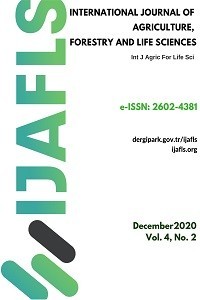Determination of the production process and some quality properties of Biga cheese dessert
Determination of the production process and some quality properties of Biga cheese dessert
Biga cheese dessert cheese-based traditional Turkish dessert, geographical origin, physico-chemical analysis, sensory evaluation,
___
- Akpınar, B. A., Ozcan, T., & Yılmaz, L. (2009). Milk-based traditional Turkish desserts. Bulgarian Journal of Agricultural Science, Mljekarstvo 59 (4), 349-355.
- Akpınar, B. A., Ozcan, T., & Yılmaz, L. (2010). A Turkish cheese-based dessert. Bulgarian Journal of Agricultural Science, 16(4), 493-499.
- Altuntaş, A., & Gülçubuk, B. (2014). Yerel Kalkınmada Yaygınlaşan Bir Araç Olarak Geleneksel Gıdalar ve Geleneksel Gıda Mevzuatının Yaygınlaştırılabilirliği. Gaziosmanpaşa Üniversitesi Ziraat Fakültesi Dergisi, 72-80.
- AOAC 2006. Protein (Crude) in Animal Feed, Combustion Method, Official Method 990.03. Official Methods of Analysis of AOAC International, 18th edition. AOAC International, Gaithersburg, MD, USA.
- AOAC 2000. Ash of cheese gravimetric method, Official Method 935.42. Official methods of analysis of AOAC International. AOAC International, Gaithersburg, MD, USA.
- Brennan, C., & Samyue, E. (2004). Evaluation of Starch Degradation and Textural Characteristics of Dietary Fiber Enriched Biscuits. Internatıonal Journal of Food Propertıes, 7 (3), 647-657.
- Cengiz, Ö. (2006). Farklı lor peyniri ve eritme tuzu ilavesi ile hazırlanan Tekirdağ peynir helvalarının çeşitli özelliklerinin belirlenmesi üzerine bir araştırma (Master’s thesis). Trakya Üniversitesi, Turkey.
- Cronin, K. & Preis, C. (2000). A Statistical Analysis of Biscuit Physical Properties As Affected By Baking. Journal Of Food Engineering, 46 (4), 217-225.
- Çağlar, A., & Çağlar, Y. (2013). Süt ve Süt Ürünleri. Uluslararası 2. Helal ve Sağlıklı Gıda Kongresi. 7-10 Kasım 2013. Konya, Turkey.
- Çakır, A., & Çakır, G. (2010). Tekirdağ Mutfağının Geleneksel Tatlılarından Hayrabolu Peynir Tatlısı’nın Trakya’da Bilinirliği ve Kemalpaşa Peynir Tatlısı ile Karşılaştırılması., Namık Kemal Üniversitesi, Hayrabolu Değerleri Sempozyumu. Tekirdağ, Turkey.
- Çakır, A., Çiftçi, G., & Çakır, G. (2017). Trakya Turizm Rotası Projesi: Lezzet Rotası Üzerine Bir Değerlendirme. Journal of Tourism and Gastronomy Studies, 5:2: 194-205.
- Çandır, A. (2010). Anadolu'nun Sahipsiz Değerleri: Yöresel Ürünler. Borsanomi Antalya Ticaret Borsası Bülteni, 25: 30-41. Doğan, M. A. (2018). Ezine Eski Kaşar Peynirinin Karakteristik Bazı Özelliklerinin Belirlenmesi (Master’s thesis). Çanakkale Onsekiz Mart Üniversitesi, Çanakkale, Turkey.
- Göncü, A. (2011). Farklı Tahıl Unları İlavesi ile Elde Edilen Fırınlanmış Buğday Cipsinin Kalite Niteliklerinin Belirlenmesi (Master’s thesis). . Erciyes Üniversitesi, Kayseri, Turkey.
- ISO (2008). Cheese And Processed Cheese-Determination Of The Total Solids Content (Reference Method), International Organization For Standardization.
- Kuşat, N. (2012). Bölgesel Kalkınmada Geleneksel Gıda Ürünlerinin Rolü ve Geleneksel Gıdalarda İnovasyon Belirleyicileri Üzerine Bir Çalışma: Afyon Örneği. Celal Bayar Üniversitesi İktisadi ve İdari Bilimler Dergisi, 19 (2): 261-275.
- Meral, R., & Doğan İ. S. (2006). Fonksiyonel Öneme Sahip Doğal Bileşenlerin Unlu Mamullerin Üretiminde Kullanımı. Gıda Dergisi, 34 (3): 193-198.
- Özen, F. B.,(2006). Tulumba tatlısının üretim metodu ile farklı un tipi ve katkı kullanımının son ürün kalitesine etkisi üzerine bir araştırma (Master’s thesis).. Selçuk Üniversitesi, Konya, Turkey.
- Romero-Lopez, M. R., Osorio-Diaz, P., Bello-Perez, L. A., Tovar, J., & Bernardino-Nicanor, A. (2011). Fiber concentrate from orange (Citrus sinensis L.) bagase: Characterization and application as bakery product ingredient. International Journal of Molecular Sciences, 12(4): 2174-2186.
- Seçim, Y., & Uçar, G. (2017). Evaluation of The Desserts; Which Are Hosmerim, Cheese Halva, Kunafah Produced in Turkish Cuisine -in Aspect of Tourism. International Journal of Social Sciences and Education Research, 3(5):1478-1484. Seçim, Y., & Uçar, G. (2018). Determination of Microbiological, Chemical and Sensory Characteristics of Höşmerim Desserts Derived From Sheep, Goat, and Cow Cheese. Eurasian Journal of Veterinary Sciences, 34(3): 156-163.
- Taş,E., Türker, S., & Ertaş, N. (2016). Bazı Kabartıcı Kombinasyonlarının Bisküvinin Kalitatif Özelliklerine Etkisi. Gıda 41(2):99-106.
- TS (2010a). Yağlı Tohumlar, Yağ Muhtevasının Tayini, 14p. Türk Standartlar Enstitüsü. TS EN ISO 659. Ankara, Turkey.
- TS (2010b). Bitkisel ve Hayvansal Yağlarda Peroksit Sayısı Tayini. Türk Standartlar Enstitüsü. TS EN ISO 3960. Ankara, Turkey.
- TS (2017a). Bisküvi Standardı. Türk Standartlar Enstitüsü. TS 2383. Ankara , Turkey.
- TS (2017b). Hamur Tatlıları-Şerbet Eklemeye Hazır Tatlılar Standardı. Türk Standartlar Enstitüsü. TS 13470. Ankara , Turkey. Uçurum, H. Ö., Kaygısız, M., & Uğur, N. (2016). Kemalpaşa Tatlısı (Peynir Tatlısı) Kalite Kriterlerinin Belirlenmesi. Gıda, 41 (4): 221-225.
- Yayın Aralığı: Yılda 2 Sayı
- Başlangıç: 2017
- Yayıncı: Volkan OKATAN
Investigation of propagation with hardwood cutting in different Prunus species
Remzi UĞUR, Muhammet Ali GÜNDEŞLİ
Olugbenga ALABI, Azeez IBRAHİM, Ebunlola OMOLE, Abiade Samson OLUMUYİWA, Olugbenga OLADELE, Olusegun Noah OSUNDIYA
Socio-economic profile of the small scale fisher: The sample of Akçakoca
Commonly Consumed Functional Foods and Food Ingredients
Kenan Sinan DAYISOYLU, Fatma Betül TEKİN SAKALLI
Micropropagation of Zinnia elegans L.
Recai ÜLFER, Nalan TÜRKOĞLU, Fethi Ahmet ÖZDEMİR
Effects of caper (Capparis spinosa L) jam on the physical and chemical properties of ice cream
Engin GÜNDOĞDU, Ahmed MENEVSEOGLU, Hilal COLAKOGLU YENİAY, Fatma HEZER
Chidinma Rosemary OKEZIE, Ifeanyı Moses KANU, Reward Onyinyechi NWOSU
Mohammed CHEURFA, Rachida ALLEM, Khawla ZABEL, Waffa AİCHOUNİ, Abdalbasit MARIOD
